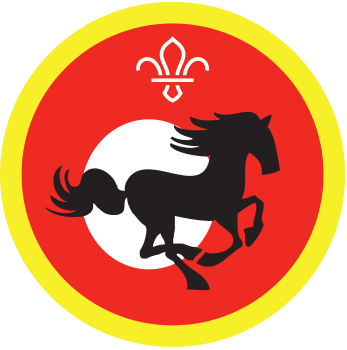Equestrian experts
You’ll need
- A4 paper
- Pens or pencils
- Container
- Helmet
- Cones
- Poles
- Skills checklist
Before you begin
- Lots of people choose to do their Equestrian Activity Badge in their own time, so we’ve attached a horse riding skills checklist to help people show that they've met the requirements. They could give it to their horse riding instructor, or a parent or carer.
- This activity gives people the chance to share their experiences with the rest of their group before everyone has a go at pretending to ride a horse.
- Set up the obstacle course at one end of the space – you'll need to set up a line of cones to be a slalom, lay a pole on the floor as a jump, and set up the ‘horses’ at the start line.
Share your experiences
- Everyone should sit in a circle. The person leading the activity should give everyone a piece of scrap paper and a pen.
- Everyone should write down any questions they have about horse riding.
- Everyone should put their questions in a container (or a helmet).
- The horse riders should take it in turns to choose a question from the hat, read it to everyone, and answer it. If they don’t know an answer, that’s OK – people can go away and find out.
Play the horse game
- Split into small teams and line up at one end of the space. Give each team a pole (or hobby horse) to ride, and a helmet to wear.
- The first player should put on the helmet and mount their ‘horse’.
- They should set off around the course. They should skilfully weave between the slalom cones, and bravely jump over the pole on the ground.
- They should return to their group, dismount their horse, and put them gently on the floor so they can rest for a moment. They should take off their helmet, and pass it to the next player.
- The next player should repeat steps two to four. Keep playing until everyone’s had a turn.
The first team to have everyone finish the course are the winners.
Reflection
This activity was a chance to think about being (and to be) physically active. If you’re one of the equestrian experts, do you enjoy horse riding as a way to be active? Even though the horse does lots of the work, you have to be active as well – how do you use your body to tell the horse what to do and where to go? Everyone had a chance to zoom around the obstacle course. Was it just about being fast, or did you also have to be agile? If you haven’t tried horse riding, do you think you’d like to give it a go?
This activity was also about developing skills. Horse riding uses lots of skills – what sorts of skills have the equestrian experts developed while horse riding (for example, balance, courage, patience)? It’s a skill to be able to share your experiences, and ask sensible and helpful questions. Did you enjoy talking about horse riding, or asking questions and finding out more? How did you communicate clearly? What skills did you use in the horse game?
Safety
All activities must be safely managed. You must complete a thorough risk assessment and take appropriate steps to reduce risk. Use the safety checklist to help you plan and risk assess your activity. Always get approval for the activity, and have suitable supervision and an InTouch process.
Make it accessible
All Scout activities should be inclusive and accessible.
